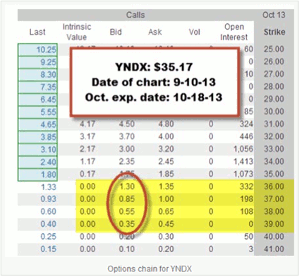Strike price selection is a critical concept needed to master covered call writing, notes Alan Ellman of TheBlueCollarInvestor.com.
Selling in-the-money strikes is the most conservative approach to this strategy and selling out-of-the-money strikes is the most bullish. We use the latter when the overall market is bullish and chart technicals are bullish and confirming. Once we have decided that a bullish approach is indicated, the next decision is how far out-of-the-money should we go when writing our calls.
Let’s first review the pros and cons of a deep OTM call vs. an OTM with a lower strike price:
Advantages
- More room for share appreciation
- Less likely to be assigned
- The net effective sale price (NESP- call strike price + call premium) is higher
Disadvantages
- Lower call premiums
- Lower final returns if share price remains static
If we decide to sell deep OTM strikes, we must be bullish on the overall market and the stock itself. The way to determine how far OTM to go, we must first set our investment goals for the month. In the BCI methodology, our goal for a one-month initial return is 2-4% for stocks and 1-2% for exchange-traded funds. Of course, each investor can tweak these guidelines based on their personal risk tolerance. The deeper OTM we go, the closer to the 2% figure we get (and then below) and the further from the 4% stat. Let’s take a look at a real-life example using one of the stocks on our current premium stock list: YNDX:
Please note the following:
- On 9-10-13, YNDX was trading @ $35.17
- We will look at the October 18 expiration, five weeks away
- We will evaluate four OTM strikes: $36, $37, $38, and $39
- Bid prices range from $1.30 down t0 $0.35
Next we will enter the options chain information into the “multiple tab” of the Ellman Calculator:
The two strikes that meet our criteria of a 2-4% initial return (ROO) are the $36 (3.7%) and $37 (2.4%) strikes. The $38 strike just misses at 1.6% but can be used at the investor’s discretion. Same holds for the $39 (1%) strike. The maximum returns for the two strikes that do meet our initial criteria are 6.1% for the $36 strike and 7.6% for the $37 strike. The ultimate decision rests with the individual investor. For me, I would opt for the $37 strike and be happy with a 2.4%, five-week return and thrilled with a 7.6% 5-week return. As always, we must follow our exit strategy guidelines once these positions are entered.
Conclusion
Deep OTM strikes can be used in a bull market environment with strong chart technicals. The higher the strike selected, the lower the initial return but the higher the maximum return possibility. Strike selection should be based on sound fundamental, technical, and common sense principles along with your personal risk tolerance comfort level.
By Alan Ellman of TheBlueCollarInvestor.com























